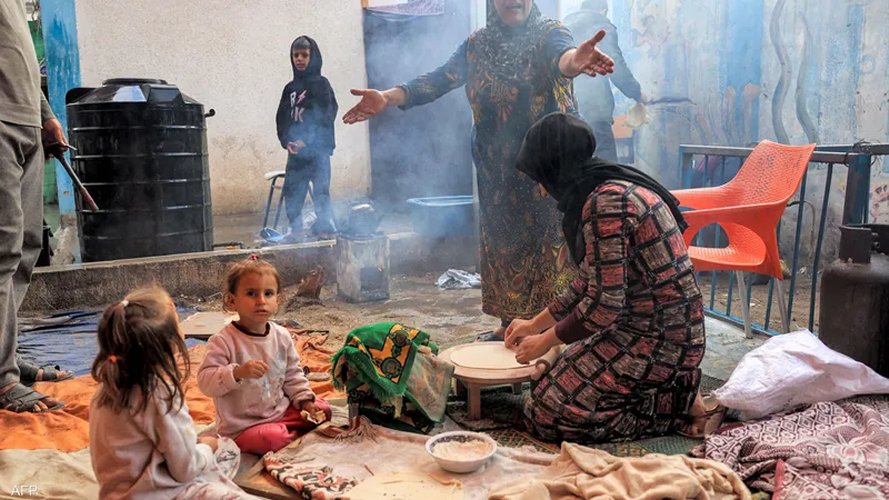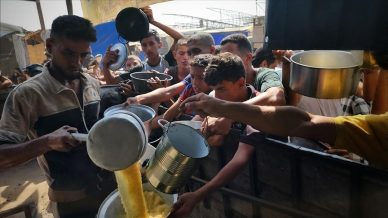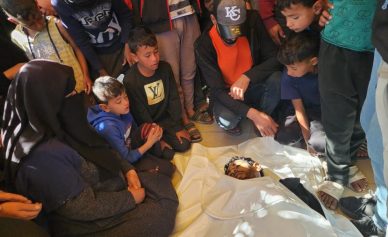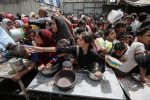GAZA, (PIC)
It is not an exaggeration when we say that famine has once again reared its head in the northern regions of the Gaza Strip. After a brief period when the occupation allowed the entry of food, fruits and vegetables, it has now tightened the siege on the city of Gaza and its north since the start of the military operation in the city of Rafah in the south of the Gaza Strip.
On May 7th, Israel took control of the Palestinian side of the Rafah border crossing with Egypt, which led to the suspension of the entry of aid into the Strip, and the suspension of the travel of the wounded and sick abroad for treatment.
The residents of the northern Gaza Strip, numbering around 700,000, are suffering from a severe shortage of food and vegetables, due to the continued closure of the border crossings by the occupation and the non-entry of trucks into the north, which is bringing the specter of famine back to the forefront again, according to local officials and international organizations.
The wanderer in what are called the “markets” in the north of the Gaza Strip is far from that, he finds nothing in them that the people can subsist on, who have now found nothing to dip their bread, which is the only thing they have left.
There are no fruits, no vegetables, no meat, no frozen foods, no canned goods, not even legumes, and the signs of malnutrition have clearly and evidently spread through the streets of northern Gaza.
A difficult situation and a real famine
In his repeated appearances on his social media accounts, journalist Mahmoud Al-Amudi is keen to document the situation that has reached the north of the Strip, where his family resides.
Last Friday, Al-Amudi appeared in one of the clips, in front of him a plate of thyme and red pepper, and a small can of luncheon meat, and he said that this is his Friday meal for him and his family, stressing that this table of his is long and wide compared to the condition of the majority of the population in the north of the Gaza Strip.
Al-Amudi confirmed in the clip that the northern Gaza Strip has not seen any kind of food supplies for a long time, especially vegetables, meat and fruits, stressing that the people of northern Gaza are patient and grateful, and satisfied with Allah’s decree, in his own words.
In another clip, Al-Amudi appeared carrying baked pastries made from flour and stuffed with weeds, and he said their taste is bitter, but it is better than eating pastries made from flour alone for him and his family.
Wandering through the markets of Gaza and the North, one stands perplexed about what can be done in the face of the difficult situation facing the markets. The stalls are empty, most of the shops are closed, and everyone is looking for something to sustain their families who await their return impatiently.
Ahmad, a father of four children, lives with his elderly parents in the Abu Iskander area north of Gaza City. He confirms to the PIC correspondent that his family only has flour left.
He explained that they have not found anything to dip their morsels in for a long time, saying: “After a slight recovery in the markets of Gaza and the North, things have become more difficult and harsher, and we no longer find what to eat, repeating our tragedy again.”
The residents of Gaza and the North Governorates have suffered a real famine in the past months, due to the Israeli prevention of supplies of food, water, medicine and fuel, which has resulted in the death of a number of children and the elderly.
Warnings and appeals
Last Wednesday, the United Nations spokesperson, Stéphane Dujarric, said that the entry of aid into the Gaza Strip has decreased by 67% since Israel occupied and closed the Rafah crossing on May 7th.
On the same day, the US Department of Defense -the Pentagon- announced that it will temporarily remove the maritime pier that its forces had recently built off the Gaza coast to deliver humanitarian aid to the Strip, in order to repair it, after one of its structural parts separated due to the violent waves.
About a week ago, relief officials and health experts warned of famine in the Gaza Strip during May, unless Israel lifts the restrictions on aid, the fighting stops, and vital services are restored, according to the American newspaper The New York Times.
According to the same newspaper, the officials said that “famine in Gaza is expected unless vital services such as healthcare and clean water, which must be present to avert malnutrition, are restored.”
They explained that hunger is escalating in Gaza as the Israeli attack on Rafah continues, the city located in the southernmost tip of the Strip.
Janti Soeripto, the president and CEO of the American organization Save the Children, said: “We have not seen anything like this (the situation in the Strip) before anywhere in the world,” according to the newspaper.
For its part, the Government Media Office (GMO) in the Gaza Strip warned of the return of famine to the city of Gaza and the north of the Strip as a result of the Israeli closure of the crossings and its prevention of the entry of humanitarian aid.
The GMO released a statement saying: “The humanitarian crisis is deepening in the Gaza Strip, with the continued occupation and closure of the Rafah crossing to the entry of aid trucks, and the obstruction of their entry through the Karam Abu Salem crossing, as Israel imposes a complete siege on the Gaza Strip.”
It added, “The specter of famine is once again threatening the Gaza and North governorates, and the food security crisis is worsening in the central and southern governorates, especially with the displacement of tens of thousands of citizens from the city of Rafah due to the invasion operation carried out by the (Israeli) occupation army.”
The GMO spokesman continued, “We confirm the dwindling relief efforts for our people, remaining below the minimum required in the face of the humanitarian disaster ravaging them.”
It mentioned that “the trucks that have entered through the American maritime pier since the start of its operation have not exceeded 100 trucks.”
While 214 trucks entered the Gaza and North governorates last week from a point established by the Israeli army west of Beit Lahia, of which 109 were loaded with flour for bakeries and citizens, and only 6 trucks of medicine, according to the GMO.
The Office called for the withdrawal of the occupation forces from the Rafah crossing, noting that the land crossings are the most beneficial and effective for delivering aid to the Gaza Strip, and for mitigating the food security crisis and preventing the famine threatening all areas of the Strip.
The war on Gaza left more than 116,000 Palestinians killed and injured, mostly children and women, and about 10,000 missing, amidst massive destruction and famine that claimed the lives of children and the elderly.
Israel continues the war despite the International Criminal Court’s intention to issue arrest warrants against the Prime Minister, Benjamin Netanyahu, and the Army Minister, Yoav Gallant, for their responsibility for war crimes and crimes against humanity, and despite the issuance of a resolution from the United Nations Security Council to immediately cease fire.














